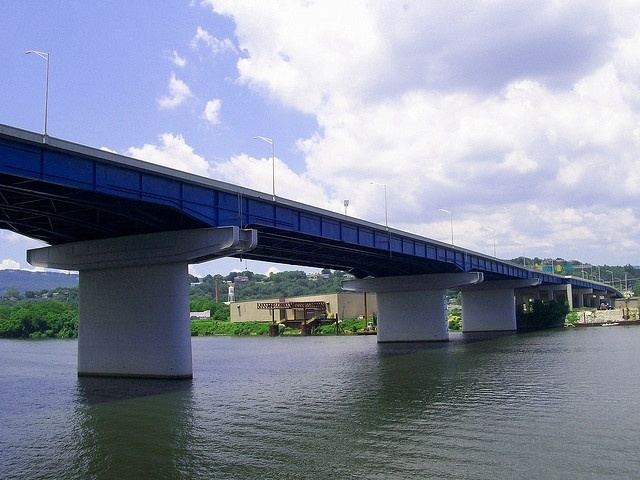Carries US 27 / SR 29 / SR 27 Locale Chattanooga, Tennessee Preceded by Market Street Bridge Opened 1959 Location Chattanooga Material Steel | Crosses Tennessee River Other name(s) Ol' Johnny Followed by Marion Memorial Bridge Body of water Tennessee River Bridge type Girder bridge Named for P.R. Olgiati | |
 | ||
Similar Tennessee River, Market Street Bridge, Walnut Street Bridge, Wilkes T Thrasher Bridge, CB Robinson Bridge | ||
The P. R. Olgiati Bridge, nicknamed the "Ol' Johnny", is a steel girder bridge across the Tennessee River in Chattanooga, Tennessee completed in 1959. It is named for former mayor and long time political boss of Chattanooga, P.R. Olgiati. Chattanooga was a growing city during the 1950s. To expand the city and to allow more ways to cross the Tennessee River, the P. R. Olgiati Bridge was one of multiple bridges built. The route carries US 27 and SR 27 across the Tennessee river.
Contents
- Map of P R Olgiati Bridge Chattanooga TN USA
- Description
- History
- Construction
- Recent developments
- Future
- References
Map of P R Olgiati Bridge, Chattanooga, TN, USA
Description
The P. R. Olgiati Bridge is located in Chattanooga, Tennessee. The bridge is one of a few major bridges that cross the Tennessee River in Chattanooga. These bridges include the Walnut Street Bridge, Market Street Bridge, Veterans Memorial Bridge, and Wilkes T. Thrasher Bridge. The P. R. Olgiati Bridge carries a controlled-access portion of US 27, which is a U.S. highway that travels south to north. The bridge crosses the Tennessee River just north of downtown, and links the freeway across the ridge en route to Signal Mountain and Red Bank. Surrounding the bridge is the Tennessee Riverwalk on the south side and just before getting to the bridge, US 27 crosses Riverfront Parkway.
History
A few years before the idea for the Olgiati Bridge became a discussion, the Wilkes T. Thrasher Bridge had been built in 1955 to provide a way of traveling across the Tennessee River. These bridge expansions were made to help the growth of Chattanooga and to expand the use of the river, as well as to provide more ways of travel. Born in 1901, in the state of Tennessee, Peter Rudolph Olgiati, mainly known as P.R. Olgiati, was appointed to the City Commission and filled the seat of an unexpired term, and later became mayor of Chattanooga for 12 years. He supported the expansion of Chattanooga and building bridges was part of his plan. The bridge expansions were made to contribute to the growth of Chattanooga and to expand the use of the river, as well as to provide more ways of travel for anyone passing through the area.
Construction
From 1946 to 1951, P.R. Olgiati was appointed to the City Commission and was elected as mayor of Chattanooga and held his position as mayor for 12 years. Olgiati became a man with great authority, power, and responsibility. He ran many of the cities departments and could use his power as an advantage to improve the city. He began his term as mayor by working to draw the state and federal officials attention. After continuous efforts to gain the approval of federal and state officials, Olgiati was granted 100 million dollars to build up the city. Because of his driven ideals, Chattanooga became the very first of any Tennessee major city to have a fully completed interstate system. The new bridge was mainly built because of the excessively used and overcrowded Market and Walnut Street bridges. The bridge was a steel girder bridge, known to be built because they are a high weight supported system. The girder refers to the I-beams that are made up of steel plates that are placed together in order to hold the bridge up. Steel bridges are known to be more costly, but, when built, are much more effective and safe. Olgiati was given the resources to build a well standing, well supported bridge, which would greatly contribute to travel in Chattanooga. To begin the building process, about one thousand buildings had to be torn down and around 1,400 families had to move. Initially, the bridge was named Cedar Street Bridge, but soon after was renamed P. R. Olgiati Bridge in regards to Mr. Olgiati's efforts to expand Chattanooga.
Recent developments
Beginning in February 1999, the Olgiati bridge was widened from four to six lanes. This was accomplished by attaching extending steel beams to the top of the posts over the river. Also in this project, a ramp was added from the bridge on the north side to Manufacturer's Road, replacing a cloverleaf loop ramp which diverged past the ramp. The project, after many delays, was completed in February 2003.
Future
In 2011, TDOT announced a plan add two more lanes to the bridge. The groundwork for extra lanes was already done in the first widening project. The project has experienced many delays, but TDOT plans to widen the bridge in a reconstruction of the portion of US 27 in downtown Chattanooga (Interstate 124) which began in late 2015, and will be complete by 2019.
